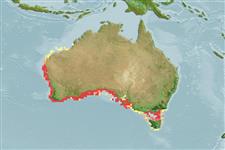Environment: milieu / climate zone / depth range / distribution range
Ecology
Marine; brackish; demersal; depth range 1 - 30 m (Ref. 9563). Subtropical; - 45°S
Eastern Indian Ocean: known only from southern Australia, from Western Australia to Victoria and Tasmania. Large adults have been misidentified as Platycephalus fuscus, the common estuarine flathead of New South Wales and southern Queensland (Ref. 9563).
Length at first maturity / Size / Weight / Age
Maturity: Lm 32.5 range ? - ? cm
Max length : 90.0 cm TL male/unsexed; (Ref. 9563)
A shallow water species, recorded from surf beaches, estuaries and in bays (Ref. 9563).
Paxton, J.R., D.F. Hoese, G.R. Allen and J.E. Hanley, 1989. Pisces. Petromyzontidae to Carangidae. Zoological Catalogue of Australia, Vol. 7. Australian Government Publishing Service, Canberra, 665 p. (Ref. 7300)
IUCN Red List Status (Ref. 130435)
Threat to humans
Harmless
Human uses
Fisheries: of no interest
More information
ReferencesAquacultureAquaculture profileStrainsGeneticsElectrophoresesHeritabilityDiseasesProcessingNutrientsMass conversion
Tools
Warning: mysqli::__construct(): (HY000/1040): Too many connections in /var/www/html/includes/speciessummary.lib.php on line 2414
Can't connect to MySQL database fbquizv2. Errorcode: Too many connections
